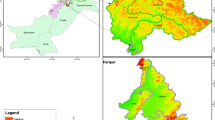Abstract
In Thailand, climate change has a direct effect on the export of food and agricultural products, which is one of the main revenue sources of the country. Furthermore, agriculture is the main income basis of local farmers; especially, in Northeast Thailand, the ratio of irrigated agricultural land was only 7.6%, and others were rainfed so that climate change makes agricultural production increasingly unstable and inflicts serious damages on the societies and economies of rural areas. In this study, we focused on weather-induced economic damages of upland crops, such as sugarcane and cassava. Firstly, we evaluated the effect of the seasonal rainfall amount and pattern on upland crop yields through correlation analysis using meteorological and agricultural statistical data. The sugarcane yield had a significant positive relationship with 4 months of accumulated rainfall. The cassava yield had a significant negative relationship with 5 months of accumulated rainfall. Secondly, a household survey was conducted to grasp the farmers’ conditions of water use, cultivation, income balance, etc. The average household income was 341,160 Baht/year, 122,433 Baht/year derived from agriculture and 218,727 Baht/year from non-agricultural work. The variation in farmers’ income in each province by crop changing was evaluated using interview results. For farmers’ livelihood, a monoculture system should be avoided because of the system’s normally high risk and its vulnerability. As a result of analysis, mixed farming of sugarcane and cassava is recommended to stabilize farming incomes both in flood and in drought years.








Similar content being viewed by others
References
National Economic and Social Development Board, Thailand (2012) The Eleventh National Economic and Social Development Plan
Sergio MV, Santiago B, Juan IL (2010) A multiscalar drought index sensitive to global warming: the standardized precipitation evapotranspiration index. J Clim 23:1696–1718
Shiraiwa T, Nakagawa H, Horie T, Matsui I, Homma K (2002) Variation of rice production in Thailand and the effect of precipitation fluctuation on production of rice (in Japanese only). Chikyu Kankyo, AIRIES 6(2):207–215
Suzuki W, Noda K, Kiguchi M, Oki K, Somchai B, Porrames A, Aphantree Y, Oki T (2014) The effect of precipitation fluctuation on production of rice and maize in North Thailand. Annu J Hydraul Eng JSCE 70(4):I_583–I_588
Yoshida K, Homma K, Maki M, Noda K, Shirakawa H, Oki K, Supranee S, Mallika S (2017) Possibility of weather-index insurance for climate change adaptation in Northeast Thailand. Glob Environ Eng Res JSCE 73(5):I_377–I_383
Author information
Authors and Affiliations
Corresponding author
Rights and permissions
About this article
Cite this article
Yoshida, K., Srisutham, M., Sritumboon, S. et al. Weather-induced economic damage to upland crops and the impact on farmer household income in Northeast Thailand. Paddy Water Environ 17, 341–349 (2019). https://doi.org/10.1007/s10333-019-00729-y
Received:
Revised:
Accepted:
Published:
Issue Date:
DOI: https://doi.org/10.1007/s10333-019-00729-y




